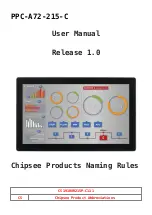
61
Figure 13.1
Touchscreen Display
Figure 13.2
Entellisys Main Menu
Entellisys Low-Voltage Switchgear
Section 13. User Interface – HMI
The touchscreen Human-Machine Interface (HMI) is
a window into the Entellisys system. All protection,
monitoring, and control is performed by the central
processing units (CPUs). The HMI, the user interface
with the Entellisys system, translates and displays
this activity. The HMI is typically placed in the
switchgear lineup or nearby in a stand-alone stack
or wall-mounted cabinet. The operator can inter-
rogate the entire system from one location, with
easy-to navigate screens providing clear information
on the power system dynamics. No longer do you
have to interpret cryptic messages on small, dimly
lit screens or wonder which button or combination
of buttons to press to find the information you
need. With the Entellisys HMI, all of the lineup
information is literally at your fingertips, on a large
screen displaying easy-to-understand information.
The HMI interface software operates as a kiosk,
meaning that this is the only software that can be
operated on this hardware. This prevents someone
from loading foreign software into the HMI computer
that would interfere with the visibility into the
Entellisys system.
The large, 15" active matrix touchscreen display
(see Figure 13.1) provides effective communication
with the system. Simply touching the on-screen
buttons moves you from screen to screen to the
information you need. The keyboard with numeric
keypad located below the screen makes data
entry fast and convenient. A USB port, in the
lower-right corner, protected by a hinged door,
provides a fast and easy way to download files via
a thumb drive, as an alternative to downloading
information over a LAN connection.
Each user is assigned a password by the system
administrator (the person at the user’s facility with
Entellisys system responsibility). Each password is
linked to various permissions so that access to
screens and authority is matched to each individ-
ual’s skill set. For instance, some operators may
only have view capability, while others are
allowed to open and close circuit breakers, while
still others have the additional ability to change
protection set points. This allows everyone to have
access to the information necessary for their own
jobs. After an operator performs what is needed,
they can log out by touching a button. Otherwise,
the HMI automatically logs out a user based on the
time selected by the site’s system administrator
(30 or 60 minutes after the last action).
The One-Line diagram is a common starting point
to view system dynamics, as illustrated in Figure
13.3. This is the default HMI screen, meaning after
a user has logged out, the HMI reverts to this screen
and the HMI is in “guest” mode. The Guest mode
allows anyone to view the one-line and many of
the other screens to gain information but does not
allow any control of circuit breakers or changes to
parameters. As seen in the Figure, this screen dis-
plays the system’s one-line diagram, with the cur-
rent for each circuit breaker, the voltage for each
bus, and the circuit breaker names and status
(open, closed, tripped). These values are dynamic
and are refreshed according to the update time
between the CPU and HMI, which is typically 2-4
seconds. The status (open, closed, trip) is also
indicated by color changes to the circuit breaker
element symbol.
Summary of Contents for Entellisys 4.0
Page 4: ...2 Notes ...
Page 6: ...4 Notes ...
Page 8: ...10 Notes ...
Page 38: ...108 Notes ...
Page 39: ...109 Entellisys Low Voltage Switchgear Appendix D Time Current Curves ...
Page 40: ...110 Appendix D Time Current Curves ...
Page 41: ...111 Appendix D Time Current Curves ...
Page 42: ...112 Notes ...














































